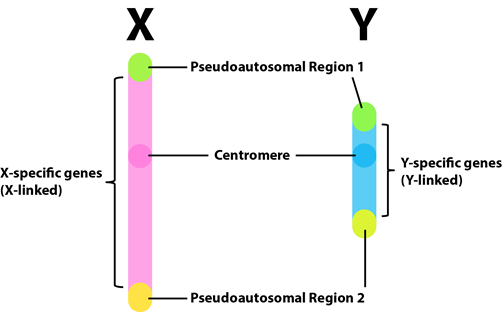10.3 Pseudo-Autosomal Regions on the X and Y Chromosomes
In evolution, before the X and Y chromosomes differentiated, they used to be equivalent homologs, like an autosome. Over time, the Y chromosome lost most of its genes (hence the reduced size), but the X chromosome retained all its genes. Thus, even though the Y chromosome has lost most of its genes, it still shares some regions with the X chromosome. This is the reason why although X and Y chromosomes are heteromorphic (morphologically dissimilar), they are able to act as a homologous pair in meiosis and undergo crossover. These common regions, which contain similar genes, permit the X and Y to pair up, and are called the “pseudo-autosomal regions”. The name comes from the observation that genes in these regions behave like autosomes in their inheritance. Alleles of the genes in this region crossover just like those on the autosomes. Thus, genes in this region are not inherited in a sex-linked pattern, even though they are located on the X chromosome.
The genes found in pseudo-autosomal region are present in two copies in both XY males and XX females, and, thus, expressed from both active and inactive X chromosomes. These genes may explain clinical features in sex chromosome aneuploidy (addition or subtraction of a sex chromosome; e.g., XXY) as gene products may be either under- or over-expressed in relation to normal females and males.
One of the genes in this region is called SHOX. It makes a protein that promotes bone growth. 46,XX and 46,XY people have two functioning copies and have average height. People with 47,XYY and 47,XXX genomes have three copies and are taller than average. And people with 45,X have one copy and are short. It is the single copy of SHOX and a few other genes in the pseudo-autosomal region that causes health problems for women with Turner syndrome.

Take a look at this video, Sex Chromosome Abnormalities, part of the AK Lectures (2015) series which discusses abnormalities which can occur with the sex chromosomes.
Media Attribution
- Figure 10.3.1 Original by Locke/Kang (2017), CC BY-NC 3.0, Open Genetics Lectures
References
AK Lectures. (2015, January 15). Sex chromosome abnormalities (video file). https://www.youtube.com/watch?v=gdXHq8FrfHI
Locke, J., Kang, M.K. (2017). Figure 3. X and Y chromosome have pseudoautosomal regions [digital image]. In Locke, J., Harrington, M., Canham, L. and Min Ku Kang (Eds.), Open Genetics Lectures, Fall 2017 (Chapter 20, p. 2). Dataverse/ BCcampus. http://solr.bccampus.ca:8001/bcc/file/7a7b00f9-fb56-4c49-81a9-cfa3ad80e6d8/1/OpenGeneticsLectures_Fall2017.pdf
Long Description
- Figure 10.3.1 An X chromosome and a Y chromosome, showing centromeres, and Pseudoautosomal regions, are able to pair up during meiosis. Crossing over does not occur, since the X and Y chromosomes are heteromorphic. However, pairing up homologous chromosomes is necessary for proper division of nuclei during meiosis. [Back to Figure 10.3.1]

